The Big Move
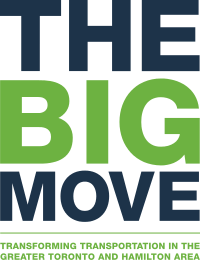 | |
|---|---|
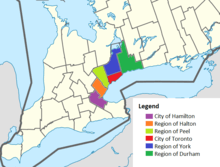 The GTHA consists of (left to right; west to east): the City of Hamilton, Halton region, Peel region, City of Toronto and York region, Durham region. | |
| Created | September 26, 2008 |
| Ratified | November 28, 2008 |
| Author(s) | Metrolinx |
| Purpose | Regional transportation plan |
The Big Move is the regional transportation plan (RTP) published by Metrolinx for the Greater Toronto and Hamilton Area (GTHA) in Ontario, Canada. It makes specific recommendations for transit projects, resulting from seven "green papers" and two "white papers" released for public discussion. A draft RTP was released alongside draft investment strategy in September 2008. After a series of stakeholder consultations and public meetings, the final RTP was approved and published by Metrolinx on November 28, 2008.
Since its publication, it has been Metrolinx's mandate to implement the RTP, which includes new and improved GO Transit service, local rapid transit, stations, and fare payment systems.
History
The Big Move was one of Metrolinx's first deliverables. The plan builds on 52 GO train, subway, light rail and bus rapid transit projects proposed by the Government of Ontario in its MoveOntario 2020 plan announced on June 15, 2007, and includes new projects to support them.
An initial stage of the RTP process was to release a series of "green papers", documents covering key issues for the RTP. These green papers were developed and consulted upon in late 2007 and early 2008, with the purpose of presenting information on transportation trends, challenges and opportunities for the GTHA:
- Paper 1: Towards Sustainable Transportation
- Paper 2: Mobility Hubs
- Paper 3: Active Transportation
- Paper 4: Transportation Demand Management
- Paper 5: Moving Goods and Services
- Paper 6: Roads and Highways
- Paper 7: Transit
The next stage was the release of two white papers in May 2008. Paper 1 - Visions, Goals, and Objectives, presented the basis for the final RTP, with specific goals and objectives that could be used for its development and evaluation. A broader proposed vision for the entire system was also presented. Paper 2 - Preliminary Directions and Concepts, looked at various policies, programs and tools that could be utilized in the RTP. There were also various transportation system concepts that were modelled and evaluated based on resulting transit ridership, urban congestion, and the emission of greenhouse gas and other air pollutants.
A draft version of the Regional Transportation Plan was provided to Metrolinx on September 26, 2008. A final version was approved on November 27, 2008.[1]
Purpose
| Forecasted Impact of The Big Move[2] | |||
|---|---|---|---|
| 2008 | 2031 | ||
| Without RTP | With RTP | ||
| Population | 6 million | 8.6 million | |
| Automobile driving distance* | 26 km | 25 km | 19 km |
| Rapid transit system length | 500 km | 525 km | 1,725 km |
| Total transit trips annually | 546,000,000 | 798,000,000 | 1,270,000,000 |
| Daily trips during morning rush hour | 467,000 | 682,000 | 1,100,000 |
| % rush hour trips taken using transit | 16.5% | 16.4% | 26.3% |
| % rush hour trips taken walking or cycling | 9.0% | 9.0% | 12.5% |
| % population within 2 km of transit | 42% | 47% | 81% |
| Commuting time* | 82 min | 109 min | 77 min |
| Transportation greenhouse gas emissions* | 2.4 t | 2.2 t | 1.7 t |
| Transportation energy consumption* | 26.4 GJ | 24.9 GJ | 19.1 GJ |
| *Average per person | |||
The GTHA is Canada's largest and fastest growing urban region, with a population forecast to grow by 2.6 million people by 2031.[3] The region is becoming increasingly dependent and designed for automobiles, and traffic congestion is already costing commuters and the economy billions of dollars every year. Nine individual local transit agencies and one regional transit agency exist, and are poorly integrated when one out of four trips crosses a regional boundary, making transit unattractive.[4] Investment in transit has been relatively stagnant, causing roads, highways and transit vehicles to be crowded and pushed to the limit.[5] In the face of climate change, increasing energy costs, increasing urbanization, and an aging population, the RTP exists to alleviate these problems.
Impact
The Big Move conducted modelling to forecast what the impact of its implementation would be in the year 2031. The proposed regional rapid transit and highway network was expected to achieve significant benefits, even with the additional population. These benefits included reduced commuting times, increased active transportation and reduced environmental impacts.[2]
Priority actions
Expanding rapid transit
The region's transportation infrastructure has been characterized as neglected from under-investment. The core of the RTP is building a seamlessly integrated regional rapid transit network consisting of 62 different rapid transit project. These projects form two long-term templates with 15 and 25 year horizons. These templates outline broad projects; specific details about technology, alignment, stations and service levels for each project are subsequently determined though a cost–benefit analysis, or an environmental assessment process.[6][7]
List of projects
The following projects are listed in The Big Move. Italicized items indicate changes made on February 14, 2013 when the Metrolinx Board of Directors endorsed an update to The Big Move.[8]
Toronto LRT projects
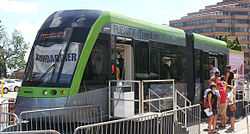
On September 28, 2012, Metrolinx signed a master agreement with the Toronto Transit Commission (TTC) to implement four new light rail transit lines in Toronto:[9]
- Sheppard East LRT
- Etobicoke-Finch West LRT
- Eglinton Crosstown line
- Replacement of the Scarborough RT.
These projects were also identified in Transit City, a rapid transit plan announced by former Toronto Mayor David Miller and TTC Chair Adam Giambrone on March 16, 2007. After $4 billion in provincial funding for Transit City from the Ontario government was deferred, the projects were rolled into a "5 in 10" plan, referring to goal of completing the four LRT lines and a BRT line in ten years.[10] The plan also included the purchase of 182 light rail vehicles from Bombardier Transportation.[11]
In December 2010, Rob Ford, who succeeded David Miller as mayor, announced his intention to cancel key parts of Transit City, saying "we will not build any more rail tracks down the middle of our streets." However, he was open to the Eglinton Crosstown LRT, given that it is primarily underground.[12] Ford acknowledged that he will need council's support to put an end to Transit City.[13] In early 2012, Toronto City Council voted in favour of motions to resume work on the Sheppard, Eglinton and Finch LRT lines, and on replacing the Scarborough RT, defeating Rob Ford's campaign for subways.[14][15]
The subway debate has continued in regards to the replacement of the Scarborough RT. Toronto City Council voted in June 2013 for a proposal to build an underground subway in Scarborough. In light of this, Metrolinx threatened to stop work on Scarborough rapid transit, or even walk away from the project. Meanwhile, the Minister of Transportation Glen Murray was open to a modified project, as long as any costs that were additional to what the province originally committed.[16] In September 2013, the Government of Ontario announced it would build a subway, but it would terminate at Scarborough Centre, and consist of “a minimum” of two stops.[17] The City of Toronto has moved forward with planning an extension of the existing Bloor-Danforth subway.[18]
Toronto subways
On November 29, 2012, Metrolinx CEO Bruce McCuaig announced two subway projects for Toronto region that would be pursued in the upcoming 15 years.[19]
- Downtown Relief Line
- Yonge subway extension
A TTC study was completed in 2012 to address existing capacity constraints on the existing Yonge subway and GO Transit lines. The study projected even with planned improvements on both networks, significant capacity issues would remain by 2031, recommending that a Downtown Relief Line be completed prior to the Yonge subway extension.[20] The Big Move initially ranked the downtown relief line as lower priority, for completion within a 25 year time frame,[7] and Metrolinx Chair Rob MacIsaac stated in 2008 that the line is unlikely to be brought forward from its projected 2020 start date.[21] By March 2012, TTC CEO Andy Byford stressed there was great need for additional subway capacity with the increasing rate of population growth in Toronto, and capacity issues along the Yonge-University subway line, stating "The downtown relief line has got to be looked at and has got to be talked about right now." Metrolinx accordingly stated that capacity issues may allow the DRL to be given higher priority in The Big Move, which was made official with the Phase 2 announcement.[22]
GO Transit improvements
GO Transit has historically offered two-way, all-day service along its Lakeshore East and Lakeshore West lines, while only providing peak rush hour service on its other lines. As part of the Ontario general election, 2011, Premier Dalton McGuinty also made a campaign pledge to provide two-way, full-day train service on all corridors, which was subsequently confirmed in the Phase 2 announcement.[19][23] It was also announced that the Kitchener and Lakeshore lines would be electrified, as well as the Union Pearson Express.[24] Other improvements included more frequent service along the Lakeshore lines, and extensions to Hamilton and Bowmanville.
LRT and BRT outside Toronto

The Hamilton B-Line was originally identified as one of the top 15 priority projects in The Big Move, and along with the A-Line, is identified for completion within 15 years. It is also part of the larger BLAST network of rapid transit proposed for Hamilton. The first phase will see the line run between the Eastgate Square Mall in Stoney Creek, and McMaster University.
The Hurontario-Main LRT in Mississauga and Brampton will represent a replacement of existing express bus services offered by MiWay and Züm. The line will run from Brampton GO Station in the north to Port Credit in the south. This will allow connections to GO Transit's Kitchener, Milton, and Lakeshore West lines, and bus terminals at Brampton GO, Brampton Gateway, Mississauga City Centre, Square One, and the Trillium Health Centre.
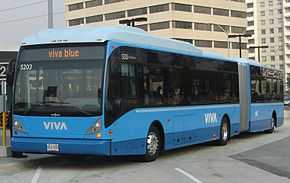
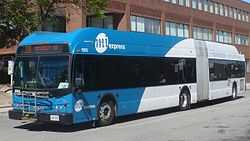
Metrolinx has also pursued constructing dedicated bus rapid transit (BRT) lanes, also known as "rapidways", in York Region and Mississauga. The first is for the Viva service in York region.[11][25] Rapidways are one element of a $1.4 billion investment into York region's transit. The BRT service will include connections with GO Transit, regional transit and future extensions of the TTC subway system. Over 34 kilometres of rapidways are planned, with the goal of buses arriving every 2 to 5 minutes. Construction began in December 2009, and all elements are expected to be completed by 2020.[25]
The Mississauga Transitway is another rapidway being built along Highway 403, Eastgate Parkway and Eglinton Avenue is being built in a partnership between the City of Mississauga and GO Transit. The transit corridor will run east-west across Mississauga, with all-station stop and extensive express bus service for thousands of riders per day. Construction began on the 18-kilometre segment between Winston Churchill Boulevard and Renforth Drive in August 2010. The first stretch opened between Hurontario Street and Dixie Road on November 17, 2014,[26] with the rest of the project targeted for opening in 2016.[27][28]
Other BRT services include the DRT Pulse, Dundas Street BRT, and the Züm Queen.
Connectivity to Pearson Airport


Having high-order transit connectivity to Toronto Pearson International Airport is the second priority action in the Big Move. The RTP identifies the following transit corridors, some of which are now in planning or construction:[29]
- Eglinton–Scarborough Crosstown line
- Etobicoke-Finch West LRT
- Mississauga Transitway
- Queen Street, Brampton/Highway 427
- Highway 427 from Kipling Station
With Pearson Airport and Union Station in downtown Toronto being seen as the two most important mobility hubs in the GTHA, the RTP specifically identified an airport rail link as being necessary between them. Discussions and studies regarding a transit link to the airport had been ongoing since the 1980s. Transport Canada began formal calls for proposals in 2001, and a contract was awarded in 2003.[30] The public-private partnership was called off in 2010 after failed negotiations, and Metrolinx was handed responsibility for the project.[31][32] Construction of the Union Pearson Express is underway, projected to be completed in time for the 2015 Pan American Games.[33]
Expanding Union Station
Union Station is Canada's busiest passenger facility and "the heart of the GTHA’s transportation system", handling 240,000 people daily, or 65 million annually.[34] However, it has been forecasted that passenger traffic is expected to quadruple in the next 25 years as a result of improvements that are called for in The Big Move, and Union Station will be at or over capacity without dramatic modifications.[34][35] Furthermore, being a National Historic Site that was built and opened in 1927, the station has been showing its age: peeling paint, cracked and damaged floors, leaky roofs, and crowded and inefficient passenger concourse spaces that were designed in the 1970s.[36][37]
The current work being undertaken includes excavation work to dramatically expand the existing GO and Via Rail concourses and create a floor dedicated to retail space, establishing new connections to the PATH network, increasing the amount of entrances, implementing energy efficiency measures and restoring heritage elements.[37] Future work could include a new train tunnel for the GO Transit Lakeshore lines, with a new station being built slightly east of Union.[35]
Integrated transit fares
There are 10 public transit agencies in the GTHA with individual fare systems. This forced some commuters to have multiple fare payment types. The Ontario Ministry of Transportation began trials for Presto, a regional fare card, in 2007. Presto was subsequently made an operating division of Metrolinx.
Presto is now available across GO Transit, seven municipal transit agencies in the GTHA (Brampton, Burlington, Durham Region, Hamilton, Mississauga, Oakville and York Region), as well as select locations across the TTC. It will also be available on the Union Pearson Express upon its opening. Fares are often cheaper than standard cash fare, and most municipal transit agencies will reduce their fare to between $0.50 and $0.75 for transferring to GO Transit.[38]
Mobility hubs
A transportation mobility hub is a major transit station and the immediate surrounding area, where different forms of transportation come together, serving as the origin, destination or transfer point for a significant amount of trips.[39]
Investment strategy
The Big Move was to be accompanied by an investment strategy, in order to cover the estimated $50 billion in capital costs for all of the identified projects. This would require the generation of $2 billion annually. While the RTP outlined the preliminary requirements, an Investment Strategy would be crafted in more detail in separate cover.[40] Metrolinx was given until June 2013 to draft such a strategy.[41]
On May 27, 2013, Metrolinx released its Investment Strategy, which would use the following tools to generate $2 billion annually for RTP projects:[42][43]
- A 1% increase in the Harmonized Sales Tax ($1.3 billion)
- A 5¢ increase in the gas tax ($330 million)
- An average charge of 25¢ on all off-street non-residential parking spaces ($350 million)
- A 15% dedication of all development charges ($100 million)
The Government of Ontario has not implemented the Investment Strategy to date. On September 18, 2013, a panel was announced to review the Investment Strategy, in order to "listen to different concerns and views and to assess them."[44] The panel recommended two variant options of Metrolinx's Investment Strategy recommendations, which relied less on a Harmonized Sales Tax increase, and more on a gas tax increase.[45]
In March 2014, the Premier of Ontario, Kathleen Wynne, rejected the proposal to raise taxes to fund the RTP outright.[46] To date, the Ontario government has raised $500 million for the Eglinton Crosstown LRT through its green bond program.[47]
References
- "The Big Move". Metrolinx. 2008. Retrieved 22 April 2015.
- ↑ Metrolinx, p. i
- ↑ 2.0 2.1 Metrolinx, p. 58-59
- ↑ Metrolinx, p. 3
- ↑ Metrolinx, p. 6
- ↑ Metrolinx, p. 7
- ↑ Metrolinx, p. 22
- ↑ 7.0 7.1 Metrolinx, p. 96
- ↑ Board Report: The Big Move Update – Recommended Changes
- ↑ Tess Kalinowski (28 November 2012). "TTC, Metrolinx finally sign off on LRTs". Toronto Star. Retrieved 28 November 2012.
- ↑ "Rapid Transit for Toronto" (PDF). City of Toronto. 8 February 2012. Retrieved 23 March 2012.
- ↑ 11.0 11.1 CBC News (14 June 2010). "Metrolinx to buy 182 streetcars". CBC News. Retrieved 26 March 2012.
- ↑ "Railway Gazette: Toronto Transit City project in doubt". 2010-12-16. Retrieved 2010-12-16.
- ↑ CBC.ca December 1, 2010
- ↑ Church, Elizabeth (8 February 2012). "TTC chair defeats Rob Ford, wins bid to bring transit above-ground". The Globe and Mail. Retrieved 8 February 2012.
- ↑ Church, Elizabeth; Kelly Grant (23 March 2012). "Transit defeat leaves Ford on rocky ground". The Globe and Mail. Retrieved 23 March 2012.
- ↑ Oliver Moore (2 July 2013). "Metrolinx to Toronto: Subway is yours". Globe and Mail. Retrieved 3 July 2013.
- ↑ "Scarborough subway to be built with shortened route, Ontario announces". Globe and Mail. 4 September 2013. Retrieved 4 September 2013.
- ↑ "Scarborough Subway Extension". City of Toronto. Retrieved 20 March 2015.
- ↑ 19.0 19.1 Metrolinx (29 November 2012). "Metrolinx Unveils Next Wave of Big Move Projects". CNW Newswire. Retrieved 30 November 2012.
- ↑ "Downtown Rapid Transit Expansion Study" (PDF). Toronto Transit Commission. September 2012. Retrieved 13 November 2012.
- ↑ Barry Hertz (2008-09-04). "New subway line still a way's off, Metrolinx head says". National Post. Retrieved 2008-09-16.
- ↑ Natalie Alcoba (2012-03-23). "TTC chief: Subway expansion for downtown relief line has to be discussed ‘right now’". National Post. Retrieved 2012-03-26.
- ↑ The Ontario Liberal Plan 2011-2015
- ↑ "Electrificationm Study Highlights" (PDF). GO Transit. Retrieved 30 November 2012.
- ↑ 25.0 25.1 "Viva in York Region". Metrolinx. Retrieved 8 March 2012.
- ↑ "Mississauga opens 4 Transitway stations". CBC News. 2014-11-17. Retrieved 2014-11-21.
- ↑ Tess Kalinowski (2014-05-06). "Key transit projects facing delays". Torstar Network, via Mississauga News. Retrieved 2014-05-24.
- ↑ "Mississauga Bus Rapid Transit (BRT) Project". GO Transit. Retrieved 8 March 2012.
- ↑ Metrolinx, p. 24
- ↑ "Transport Minister Announces Winning Proposal for Toronto Air-Rail Link" (Press release). Ottawa: Transport Canada. 2003-11-13. Archived from the original on 2011-11-30. Retrieved 2011-11-30.
- ↑ Kalinowski, Tess (2010-07-31). "Province vows rapid rail link to Pearson by 2015 Pan Ams". The Toronto Star (Toronto). Archived from the original on 2011-11-30. Retrieved 2011-08-08.
- ↑ CNW Group (30 July 2010). "Metrolinx to build, own and operate Air Rail Link". CNW Group. Retrieved 8 August 2011.
- ↑ "Georgetown South Project". GO Transit. Retrieved 7 August 2011.
- ↑ 34.0 34.1 Metrolinx, p. 25
- ↑ 35.0 35.1 "Union Station 2031 and Related Planning Studies" (PDF). Metrolinx. 23 November 2011. Retrieved 24 June 2012.
- ↑ "About Union Station". City of Toronto. Retrieved 24 June 2012.
- ↑ 37.0 37.1 "About the revitalization". City of Toronto. Retrieved 24 June 2012.
- ↑ About PRESTO
- ↑ "Metrolinx Mobility Hubs". Metrolinx. Retrieved 28 November 2012.
- ↑ Metrolinx, p. 68-74
- ↑ Will province drag its feet on regional transit taxes?
- ↑ STABLE FUNDING TO INVEST IN OUR REGION
- ↑ INVESTMENT STRATEGY
- ↑ Province announces advisory panel to review Metrolinx investment strategy
- ↑ Hike gas tax to pay for new Toronto transit, panel recommends
- ↑ Ontario won't hike HST or gas tax to pay for transit, Wynne says
- ↑ Strong Demand for Ontario's First Green Bond
External links
| ||||||||||||||||||||
| ||||||||||||||||||||||
| |||||||||||||||||||||||||||||||||||||||||||||

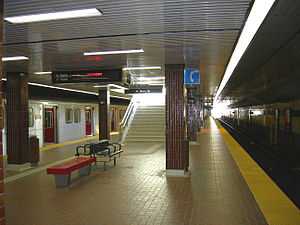
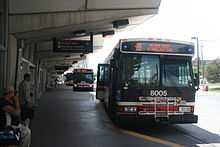


_(14918534190).jpg)